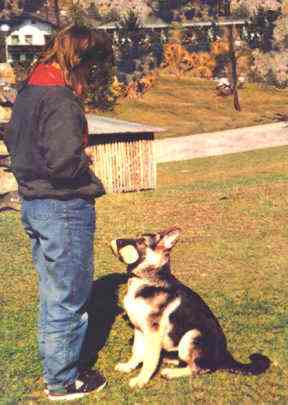The site was last updated on
24 Aug 2000
Choosing a Puppy for Schutzhund
In every breed, the pedigree is the key to knowing the potential of the puppy. Schutzhund revolves around working lines - generations of dogs that have proven themselves and produced similar characteristics in their offspring. These characteristics include not only the physical structure of the dog, which is very important, but also its temperament.
Selecting the bloodlines from which you want your puppy may require advice. Information from breed surveys can help. Of course, it makes sense to discuss your objectives with reputable and experienced Schutzhund handlers or enthusiasts.
Once you have determined that the bloodlines of the potential dam and sire are of high quality, you should observe the parents, especially the mother, if that is at all possible. The dam will be the main influence on the young pup for the first six weeks of its life. If the dam is nervous or unsure, chances are this uncertainty will be transferred to the offspring.
If you are able to see the litter, watch the puppies together and also separately, to try to determine which is the best puppy. Obvious structural defects or health problems should be watched for.
It is important that the puppy have intense instinct to stalk the prey - a ball, a toy, etc. - and also be the leader in the sense of bullying the other puppies. The puppy should not show fear when away from its littermates. It should not need to stay with the mother. The puppy should be adventurous and active, playing with objects shown to it by someone in the enclosure, but it should be independent enough to take that object and go off on its own as well.
It is independence and confidence, combined with the positive contact with the pack leader (the dam, at this time) that will develop into the traits of trainability that you need.

Raising a Puppy for Schutzhund Work
Puppyhood is the most critical period for the development of the characteristics you want to encourage. Your local Schutzhund club can advise you about nurturing and socializing your growing puppy.
A puppy learns from its experiences, so you want to provide only positive ones. It should be provided with opportunity to explore and investigate new situations and new people, but always in a non-threading way. Remember that your goal is to build confidence in the young animal. Your aim is not to dominate or oppress the young pup.
Exposure to different environments is crucial to the general education of the dog and also to assure it that the world is a safe place. If something appears to make the dog unsure, give it the opportunity to investigate it slowly, but do not force the issue.
It is imperative to avoid situations where another, older or stronger would dominate your dog or by another puppy. You also want to avoid having to discipline or correct your puppy and thus dampen its spirit or damage its self-confidence. You can do this by never leaving the pup in a situation where it can cause damage to your valuables or find itself in a dangerous predicament.
The final area of development is that of drive encouragement. The natural behaviors that you want to encourage are playing with the ball, tug of war, hide and seek, pulling toys on a string, pursuing you rapidly when you run away, and finally defending itself, its family, and its home. The latter really only shows itself between the ages of 9 and 18 months, as the pup begins to mature, by barking at strangers or intruders.
It is better to leave for later formal obedience training with a young dog. The character of the puppy is not sufficiently strong to withstand the corrections involved in obedience training. Acceptable manners at home and in the car and "play" training, like learning to sit for a food reward, with no corrections involved, is advisable. Real obedience work should begin only after the dog is well on its way in the protection training.